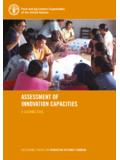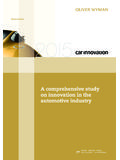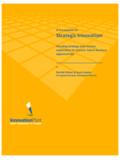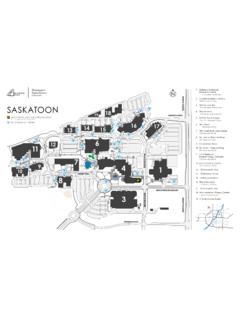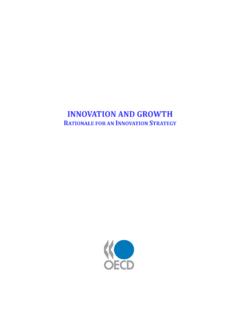Transcription of T OOL K IT By thoroughly mapping the The Customer- done, a ...
1 OOL K IT The Customer- centered innovation Map by Lance A. Bettencourt and Anthony W. Ulwick Included with this full-text Harvard Business Review article:The Idea in Brief the core ideaThe Idea in Practice putting the idea to work 1 Article Summary 2 The Customer- centered innovation MapA list of related materials, with annotations to guide furtherexploration of the article s ideas and applications 8 Further ReadingBy thoroughly mapping the job a customer is trying to get done, a company can discover opportunities for breakthrough products and services. Reprint R0805H T OOL K IT The Customer- centered innovation Map page 1 The Idea in BriefThe Idea in Practice COPYRIGHT 2008 HARVARD BUSINESS SCHOOL PUBLISHING CORPORATION. ALL RIGHTS RESERVED. We all know that people hire products to get jobs done.
2 Office workers hire word-processing software to create documents. Surgeons hire scalpels to dissect soft tissue. But few companies keep this in mind while searching for ideas for breakthrough offer-ings. Instead, they rely on inquiry methods (such as customer interviews) that don t generate the most promising ideas or exhaustive sets of systematically uncover more and better innovative ideas, Bettencourt and Ulwick recommend job mapping : Break down a job that customers want done into discrete steps. Then brainstorm ways to make steps easier, faster, or example, while cleaning clothes, people don t notice stubborn stains until they ve taken the clothes from a dryer and started folding them. If they find a stain, they must repeat the job. A washer that detects per-sistent stains and takes appropriate action before consumers execute the rest of the job would have huge jobs have the same eight steps.
3 To use job mapping , look for opportunities to help customers at every step:During this can innovate : DefineDetermine their goals and plan Watchers streamlines diet planning by offering a system that doesn t require calorie : LocateGather items and information needed to do the required inputs easier to gather and ensuring they re available when and where provides customers with prepackaged moving kits containing the number and types of boxes required for a : PrepareSet up the environment to do the set-up less difficult and creating guides to ensure proper set-up of the work added adjustable levers to its circular saw to accommodate common bevel angles used by roofers to cut : ConfirmVerify that they re ready to perform the customers information they need to confirm s ProfitLogic merchandising optimization software confirms optimal timing and level of a store s markdowns for each : ExecuteCarry out the problems or s Patient Warning System automatically circulates heated water through thermal pads placed on surgery patients to maintain their normal body temperature during : MonitorAssess whether the job is being successfully monitoring with improved makes a running shoe containing a sensor that communicates audio feedback about time, distance, pace, and calories burned to an iPod worn by the.
4 ModifyMake alterations to improve the need to make alterations and the number of alterations automatically downloading and installing updates, Microsoft s operating systems remove hassle for computer users. People don t have to determine which updates are necessary, find the updates, or ensure the updates are compatible with their operating : ConcludeFinish the job or prepare to repeat products that simplify the process of concluding the makes a wound dressing that stretches and adheres only to itself not to patients skin or sutures. It thus offers a convenient way for medical personnel to secure dressings at the conclusion of treatment and then remove them after a wound has OOL K IT The Customer- centered innovation Map by Lance A. Bettencourt and Anthony W. Ulwick harvard business review may 2008page 2 COPYRIGHT 2008 HARVARD BUSINESS SCHOOL PUBLISHING CORPORATION.
5 ALL RIGHTS RESERVED. By thoroughly mapping the job a customer is trying to get done, a company can discover opportunities for breakthrough products and services. We all know that people hire products andservices to get a job done. Office workers hireword-processing software to create documentsand digital recorders to capture meeting hire scalpels to dissect soft tissue andelectrocautery devices to control patientbleeding. Janitors hire soap dispensers, papertowels, and cleansing fluid to help removegrime from their all this seems obvious, very fewcompanies use the perspective of gettingthe job done to discover opportunities forinnovation. In fact, the innovation journey formany companies is little more than hopefulwandering through customer interviews.
6 Suchunsystematic inquiry may occasionally turnup interesting tidbits of information, but itrarely uncovers the best ideas or an exhaus-tive set of opportunities for have developed an efficient yet simplesystem companies can use to find new ways toinnovate. Our method, which we call jobmapping, breaks down the task the customerwants done into a series of discrete processsteps. By deconstructing a job from beginningto end, a company gains a complete view ofall the points at which a customer might de-sire more help from a product or service namely, at each step in the job. With a jobmap in hand, a company can analyze thebiggest drawbacks of the products and servicescustomers currently use. Job mapping alsogives companies a comprehensive frameworkwith which to identify the metrics customersthemselves use to measure success in execut-ing a task.
7 (For a description of these metricsand a discussion about how to gather andprioritize them, see Anthony W. Ulwick s Turn Customer Input into innovation inHBR s January 2002 issue.)Job mapping differs substantively from pro-cess mapping in that the goal is to identifywhat customers are trying to get done at everystep, not what they are doing currently. Forexample, when an anesthesiologist checks amonitor during a surgical procedure, theaction taken is just a means to an end. Detect-ing a change in patient vital signs is the job The Customer- centered innovation Map T OOL K IT harvard business review may 2008page 3 the anesthesiologist is trying to get mapping out every step of the job andlocating opportunities for innovative solutions,companies can discover new ways to differen-tiate their offerings.
8 Anatomy of a Customer Job Over the past 10 years, we have mapped cus-tomer jobs in dozens of product and servicecategories that span professional and con-sumer services, durable and consumable goods,chemicals, software, and many other indus-tries. Our work has revealed three fundamen-tal principles about customer jobs are processes. Every job, fromtransplanting a heart to cleaning a floor, hasa distinct beginning, middle, and end, andcomprises a set of process steps along the starting point for identifying innovationopportunities is to map out from the cus-tomer s perspective the steps involved inexecuting a particular job. Once the stepsare identified, a company can create value ina number of ways by improving the execu-tion of specific job steps; eliminating the needfor particular inputs or outputs; removingan entire step from the responsibility ofthe customer; addressing an overlooked step;resequencing the steps; or enabling steps tobe completed in new locations or at mapping the job of washing clothes,for example, a company would quickly dis-cover that the step of verifying that stainshave been removed often comes at the endof the job sequence, after the clothes havebeen removed from the washing machine,dried, folded, and put away too late to domuch of anything about it.
9 If the washingmachine itself could detect the presence ofany remaining stains before the wash cycleended resequence when verification takesplace it could take the necessary actions at amuch more convenient point in the job. If themachine could be designed to remove theneed for inputs such as stain removers andbleach, that would be even jobs have a universal structure. Thatuniversal structure, regardless of the cus-tomer, has the following process steps: definingwhat the job requires; identifying and locatingneeded inputs; preparing the componentsand the physical environment; confirmingthat everything is ready; executing the task;monitoring the results and the environment;making modifications; and concluding the problems can occur at many pointsin the process, nearly all jobs also require aproblem resolution steps are more critical than others,depending on the job, but each is necessary toget the job done successfully.
10 For example,when preparing for the task of replacing a hipjoint, surgeons sterilize their hands, establisha sterile field between their body and thepatient, prep the patient s skin for the incision,and properly position the patient. A janitorabout to clean his hands might prepare bysimply rolling up his sleeves. innovation possi-bilities reside within each of the job are separate from solutions. Customershire different products or services to get thesame job done. When preparing income taxes,for example, one person might rely on the ser-vices of a CPA, whereas another might use taxpreparation software. Others might hire bothfor different steps in the companies are focused on the prod-uct or service they re already developing, oron the one the competition is offering, ratherthan on the help they must give the customerto execute the steps in a job.
